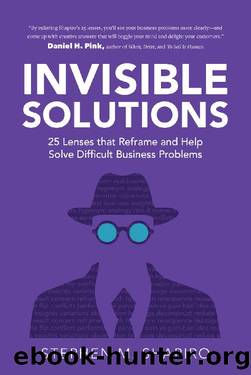Invisible Solutions: 25 Lenses that Reframe and Help Solve Difficult Business Problems by Stephen Shapiro

Author:Stephen Shapiro [Shapiro, Stephen]
Language: eng
Format: epub
Publisher: Amplify Publishing
Published: 2020-03-03T05:00:00+00:00
Try increasing your goals to stretch your thinking. If you ask âHow can we get a 5 percent improvement?â you get incremental thinking. But if you ask âHow can we get a 50 percent or 100 percent improvement?â the old models of thinking wonât work, which forces you to devise new approaches and solutions.
Stretch goals are ideal during the innovation process when you are developing solutions. However, they might not be the right strategy for measuring day-to-day performance of employees as they can lead to the dysfunctional behaviors described in the REDUCE lens (#3). (Wells Fargo learned this lesson when their overly aggressive cross-sale goals led employees to open unneeded accounts for customers, sometimes forging client signatures on paperwork.)
It should be noted that this lens is often used in conjunction with other lenses. Once youâve established a stretch target, you may need to reframe the problem again to generate better solutions.
Examples of This Lens in Action
At a large greeting-card company, cards took eighteen to twenty-four months to move from concept to store shelves. Senior executives set a stretch goal of getting new cards from concept to market in less than a year. Individual departments within the firmâdesigners, writers, artists, printers, shippers, and so onâbelieved this new stretch goal could not be met. Even so, the target became a rallying cry. In the end, the company managed to get its cards to market in only four months. The seemingly impossible goal had forced the teams to abandon their conventional approaches and to try something completely new. Previously untried forms of cross-departmental collaboration were part of the solution.
One of the most well-known examples of setting stretch goals comes from President John F. Kennedyâs challenge to the United States to âput a man on the moon by the end of the decade,â which sounded completely impossible to most people at the time. This stretch goal, proposed on May 25, 1961, was met on July 20, 1969, with the Apollo 11 mission.
Download
This site does not store any files on its server. We only index and link to content provided by other sites. Please contact the content providers to delete copyright contents if any and email us, we'll remove relevant links or contents immediately.
Hit Refresh by Satya Nadella(9040)
The Compound Effect by Darren Hardy(8817)
Change Your Questions, Change Your Life by Marilee Adams(7637)
Nudge - Improving Decisions about Health, Wealth, and Happiness by Thaler Sunstein(7622)
The Black Swan by Nassim Nicholas Taleb(7016)
Deep Work by Cal Newport(6886)
Daring Greatly by Brene Brown(6449)
Rich Dad Poor Dad by Robert T. Kiyosaki(6413)
Principles: Life and Work by Ray Dalio(6223)
Playing to Win_ How Strategy Really Works by A.G. Lafley & Roger L. Martin(5934)
Man-made Catastrophes and Risk Information Concealment by Dmitry Chernov & Didier Sornette(5925)
Digital Minimalism by Cal Newport;(5667)
Big Magic: Creative Living Beyond Fear by Elizabeth Gilbert(5616)
The Myth of the Strong Leader by Archie Brown(5428)
The Slight Edge by Jeff Olson(5353)
Discipline Equals Freedom by Jocko Willink(5288)
The Motivation Myth by Jeff Haden(5158)
Stone's Rules by Roger Stone(5027)
The Laws of Human Nature by Robert Greene(5002)
